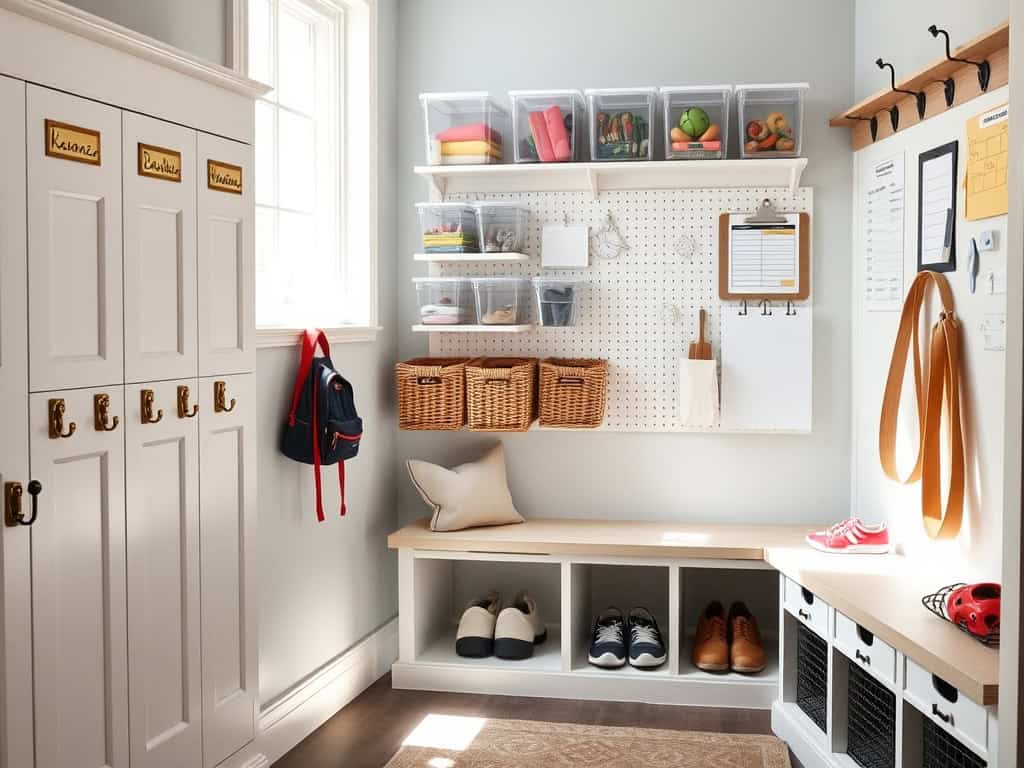If you’re living with kids, you know the daily struggle of keeping school supplies and paperwork under control. I’ve been there – watching backpacks explode across the floor and frantically searching for permission slips five minutes before the bus arrives. But here’s the good news: with eight smart storage solutions, you can transform your home from chaos to calm. Let me show you how to create systems that’ll work for both you and your kids.
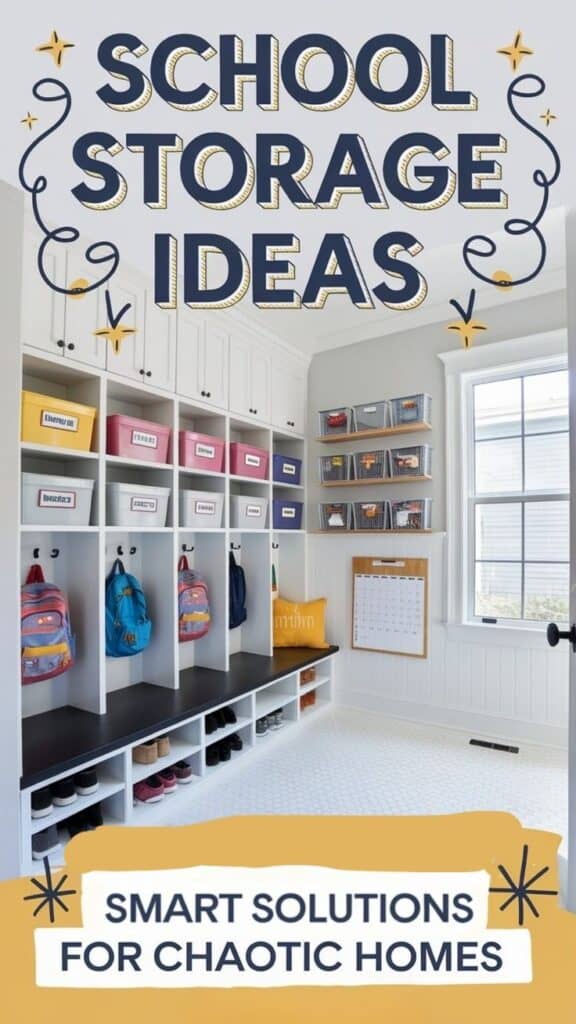
Create a Backpack Command Center
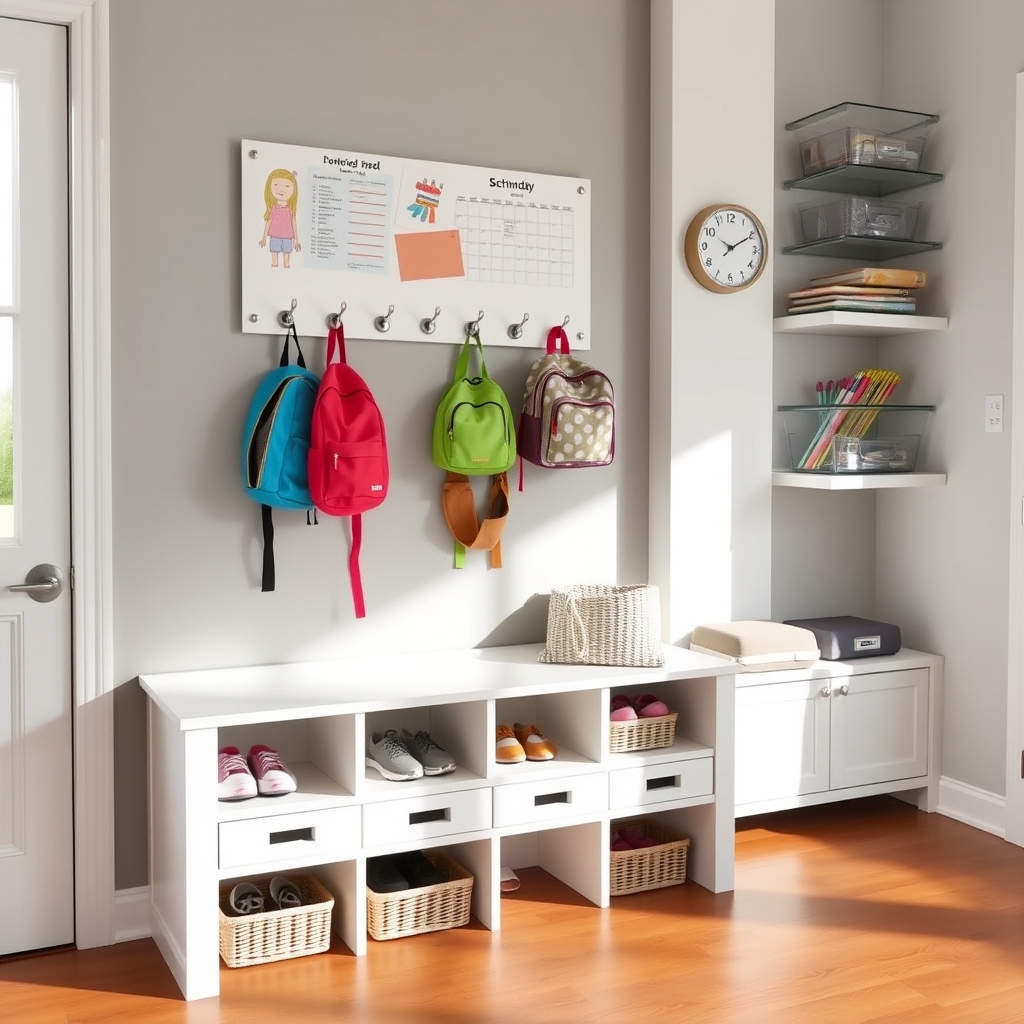
School Storage Ideas for Organized Homes With Kids:
Create a Backpack Command Center
A backpack command center serves as the cornerstone of an organized school routine, preventing the morning chaos of searching for homework, permission slips, and essential school items. This dedicated space acts as a central hub where children can easily access and store their school materials, promoting independence and responsibility.
Creating this organized zone not only streamlines morning departures but also establishes a reliable system for after-school unpacking. When children know exactly where to place their belongings, they’re more likely to maintain organization habits and complete homework assignments without losing important documents.
Required Items:
- Wall hooks or rack for backpacks
- Storage bench or cubbies
- Labels or name tags
- Wall-mounted file holders
- Bulletin board or magnetic board
- Storage bins or baskets
- Command hooks
- Shelf unit
- Clear containers for supplies
- Clock
Select a convenient location near your home’s entrance and install wall-mounted hooks at child-appropriate heights for backpacks. Position a storage bench or cubby system below the hooks to accommodate shoes and additional school items.
Mount a bulletin board or magnetic board at eye level for displaying important papers, schedules, and reminders. Install wall-mounted file holders for each child to sort homework and permission slips.
Create designated zones within the command center for different activities: homework supplies in clear containers, a charging station for electronic devices, and labeled bins for sports equipment or special activities. Establish a spot for incoming papers that need parent attention and outgoing items that must return to school.
Implement a daily check-in routine where children empty lunch boxes, remove completed homework, and organize materials for the next day. Consider incorporating a weather station or weekly schedule display to help children prepare for upcoming activities.
Label everything clearly and create visual guides for younger children to maintain the system independently.
Design Smart Homework Stations
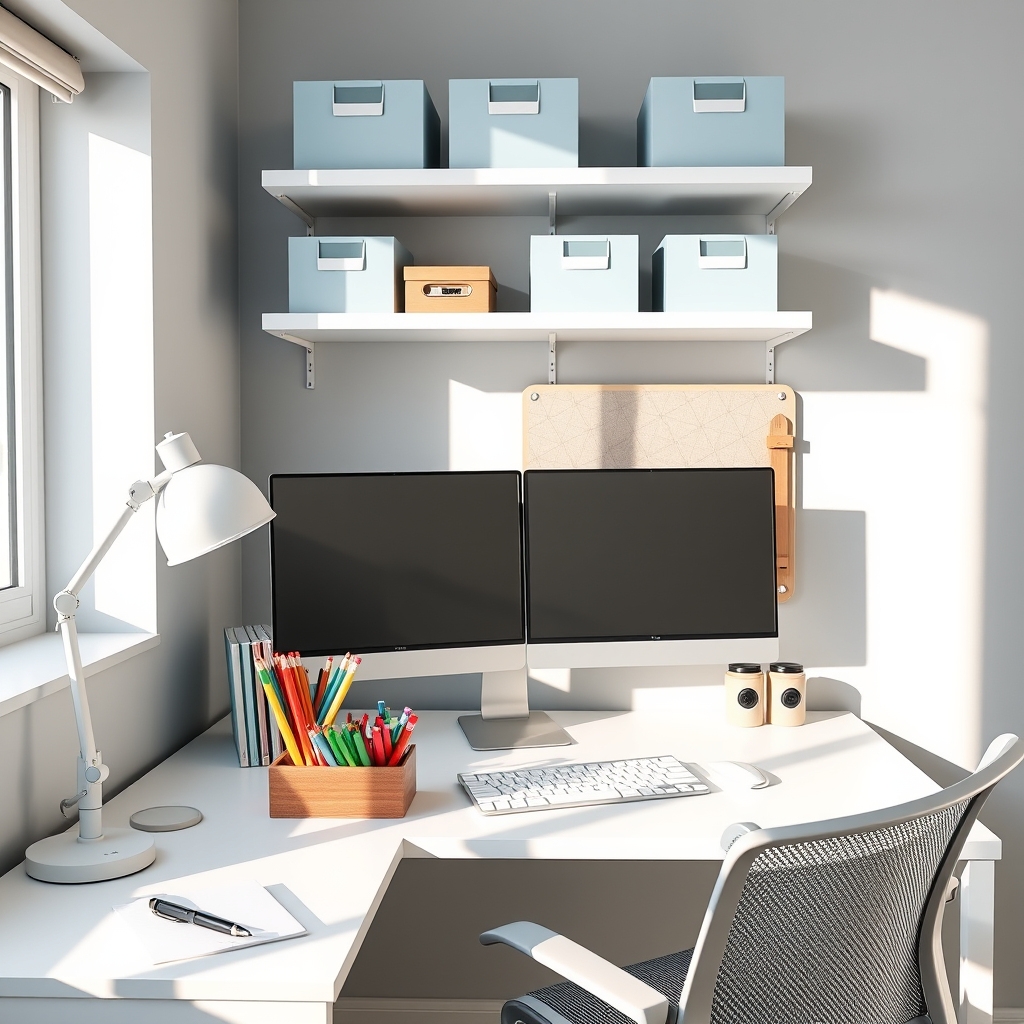
School Storage Ideas for Organized Homes With Kids
Design Smart Homework Stations
A well-designed homework station is crucial for supporting children’s academic success and developing strong study habits. When students have a dedicated space for learning, they can focus better, stay organized, and complete assignments more efficiently without unnecessary distractions.
Creating an effective homework station requires careful consideration of ergonomics, storage solutions, and organizational systems that match your child’s age and learning style. The right setup can transform a simple desk area into a productivity hub that encourages independence and academic achievement.
Required Items:
- Desk or table at appropriate height
- Comfortable chair
- Task lighting
- Storage containers or organizers
- File folders or document organizers
- Supply caddy or pencil holders
- Calendar or planner
- Bulletin board or whiteboard
- Power strip for electronics
- Label maker
- Storage bins for textbooks
- Desktop shelving unit
Select a quiet location away from high-traffic areas and set up the desk facing a wall to minimize distractions. Install adequate lighting with a combination of ambient and task lighting to reduce eye strain.
Create designated zones within the workspace: one for current assignments, another for supplies, and a third for reference materials and textbooks. Incorporate vertical storage using wall-mounted organizers or shelving to maximize space efficiency.
Establish a color-coding system for different subjects using folders, bins, or labels to help maintain organization. Position frequently used items within arm’s reach and store lesser-used supplies in drawers or containers. Ensure all electronic devices have easy access to power outlets while keeping cords neat and organized using cable management solutions.
Additional Tips:
Regular maintenance is key to keeping the homework station functional. Schedule weekly cleanup sessions with your child to sort through papers, replenish supplies, and reorganize materials.
Consider implementing a paper management system where completed assignments are filed or discarded promptly to prevent clutter accumulation. Adjust the station’s layout and organization systems as needed based on your child’s changing needs and work habits throughout the school year.
Set Up a Paper Processing System
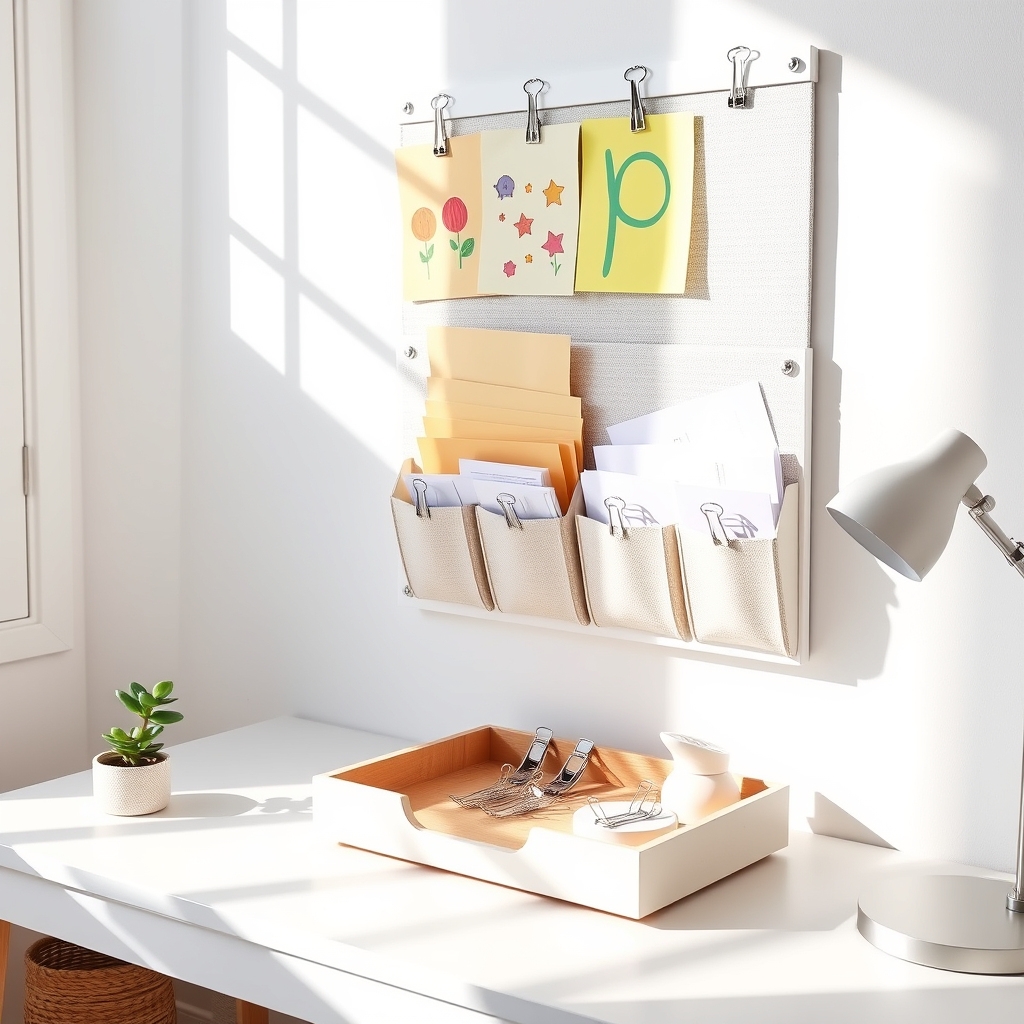
School Storage Ideas for Organized Homes With Kids
Set Up a Paper Processing System
Managing the constant flow of school papers, artwork, and permission slips can quickly become overwhelming for parents. Without a proper system in place, important documents get lost, deadlines are missed, and cherished artwork ends up crumpled at the bottom of backpacks. A well-organized paper processing system helps maintain order and peace of mind.
Creating designated spaces and routines for handling school-related papers not only reduces clutter but also teaches children responsibility and organizational skills. When everyone knows exactly where papers should go and how they should be handled, mornings become smoother, and important information stays readily accessible.
Required Items:
- Wall-mounted file holder or desktop organizer
- Labeled hanging files or folders
- Action file folders (To Do, To Sign, To File)
- Paper clips or binder clips
- Label maker or labels
- Storage bin for artwork
- Magnetic clips for display
- Scanner or smartphone scanning app
- Recycling bin
Start by establishing a command center near your home’s entry point or kitchen. Create three main zones: immediate action, reference, and archive. Set up hanging files labeled for each child and subcategories like “Current Assignments,” “Complete Work,” and “Important Documents.” Include an “Action Required” folder for items needing immediate attention, such as permission slips or forms requiring signatures.
For artwork and memorable papers, implement a two-step process. First, display current pieces using magnetic clips or a designated wall space. Second, photograph or scan items you want to preserve digitally, then store physical pieces you want to keep in a labeled storage bin.
Establish a regular routine to sort through papers, ideally daily or at least weekly, to prevent overwhelming buildup.
Additional Tips: Set calendar reminders for weekly paper processing sessions and involve your children in the organizing process. Teach them to sort their own papers into the appropriate folders when they return from school.
Consider creating a digital backup of important documents using a scanning app, and implement a one-in-one-out rule for artwork to prevent overflow. Remember to purge and archive papers at the end of each school year to maintain the system’s effectiveness.
Organize Art Supply Storage
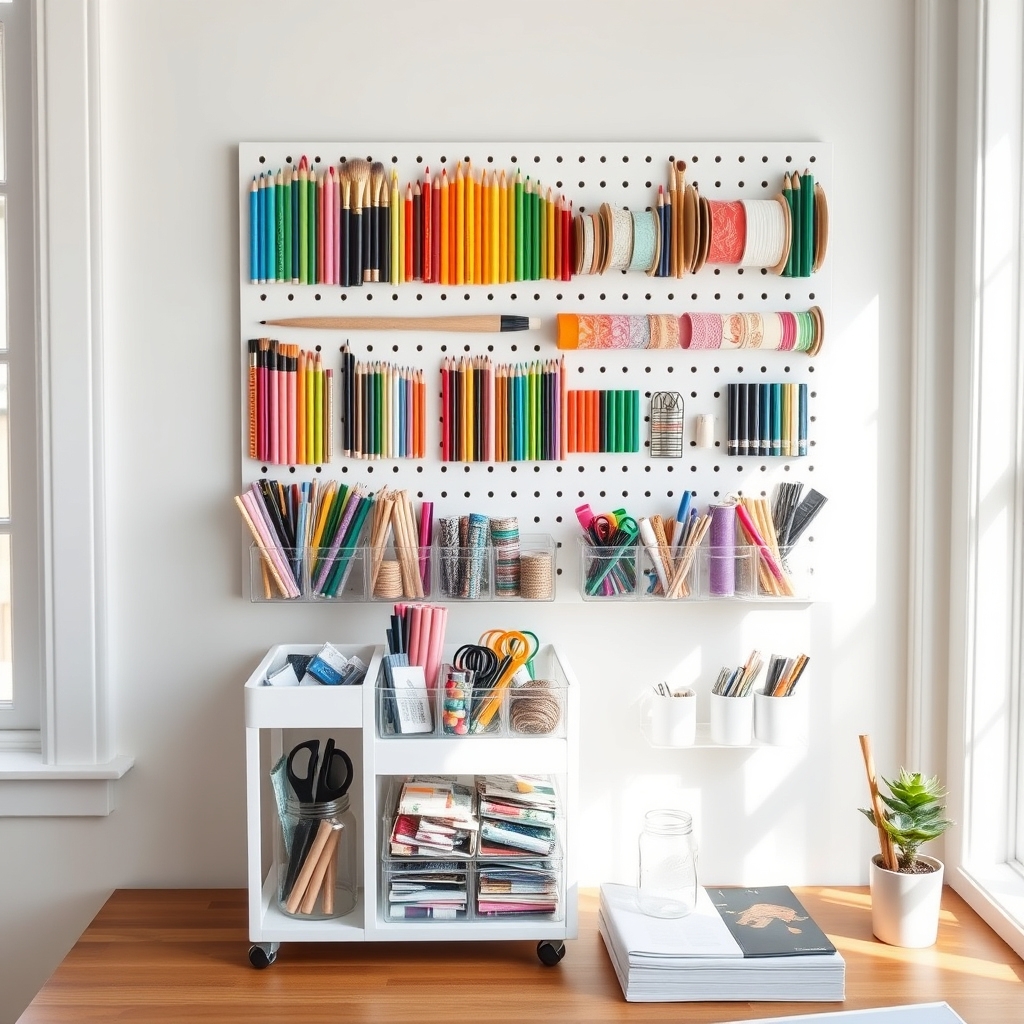
Organizing art supplies is crucial for fostering creativity while maintaining an orderly learning environment. When art materials are properly sorted and easily accessible, children are more likely to engage in creative activities independently and clean up afterward. A well-organized art supply system also prevents waste, helps track inventory, and makes it simpler to identify when items need replenishing.
An effective art supply organization system can transform a chaotic craft corner into an inspiring creative space. This organization not only protects valuable supplies from damage but also teaches children responsibility and helps them develop organizational skills they can use throughout their lives.
Required Items:
- Clear plastic containers
- Label maker or labels
- Storage cart with drawers
- Mason jars or cups
- Pencil holders
- Drawer dividers
- Plastic bags
- Storage bins
- Paper organizers
- Supply caddy
- Wall-mounted organizers
- Shelf risers
Start by sorting all art supplies into categories: drawing tools, paints, paper products, crafting materials, and tools. Discard dried-out markers, broken crayons, and any damaged supplies. Group items by frequency of use, keeping regularly used supplies easily accessible.
Install wall-mounted organizers or shelving units at child-height for frequently used items, and store occasional-use supplies in clearly labeled containers on higher shelves.
Implement a color-coding system for different supply categories, using coordinated containers and labels. Store liquid supplies like paint and glue in spill-proof containers, and keep messy materials in water-resistant bins. Use clear containers whenever possible to make supplies visible and appealing.
Create designated zones for wet and dry materials, and establish a specific area for works in progress.
Additional Tips: Rotate supplies seasonally to keep the creative space fresh and engaging. Consider creating portable art kits for specific projects to prevent all supplies from being accessed at once. Review and reorganize the system quarterly, involving children in the process to maintain their investment in keeping supplies organized.
Use vertical space whenever possible, and keep a supply inventory list to avoid overbuying or running out of essential items.
Build a Grab-and-Go School Supply Zone
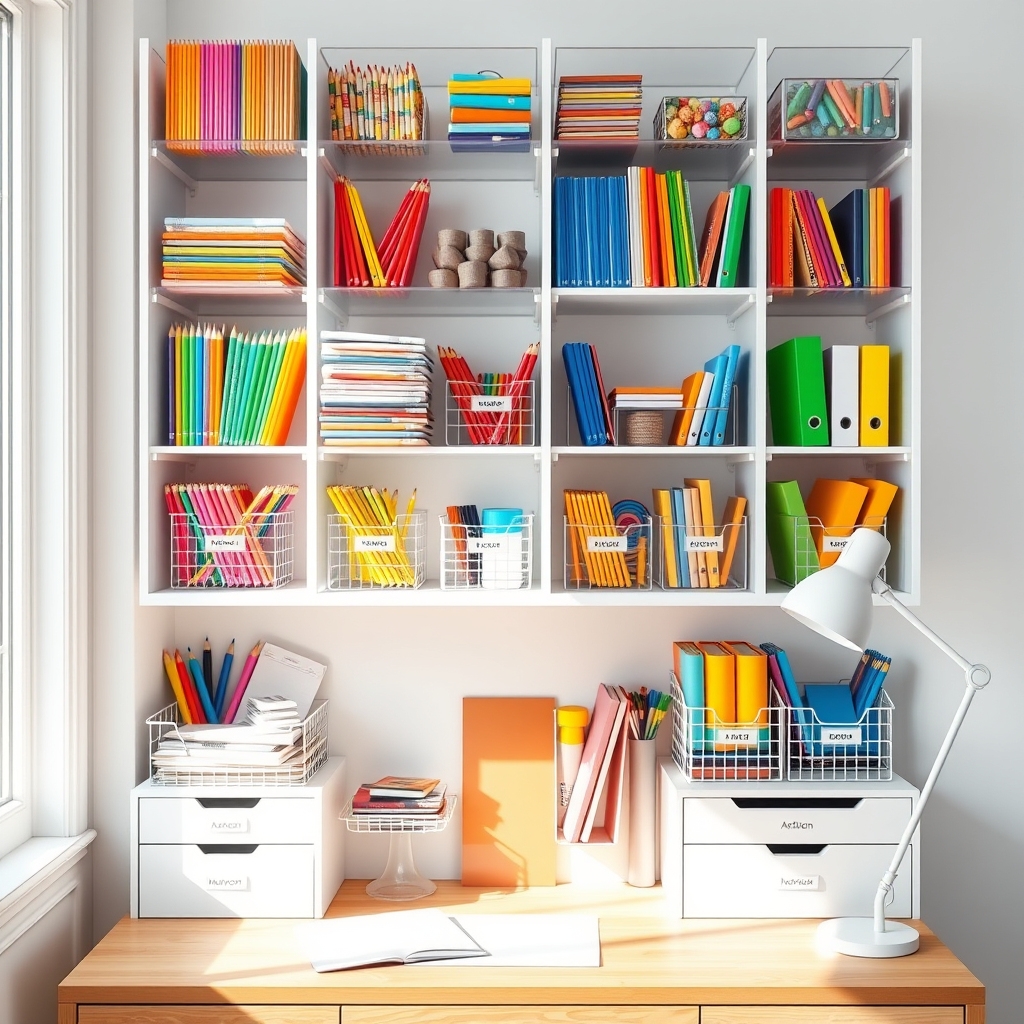
Creating a dedicated school supply zone eliminates the daily stress of hunting down essential items during busy mornings. When children know exactly where to find their supplies, they develop independence and responsibility while reducing the chaos of last-minute searches for missing items.
A well-organized grab-and-go zone serves as a central command center for school preparations, homework sessions, and project completion. This designated area becomes a reliable spot where supplies remain consistently stocked and accessible, preventing duplicate purchases and ensuring students always have the tools they need to succeed.
Required Items:
- Clear storage containers or bins
- Label maker or labels
- Desktop organizers or pencil holders
- Wall-mounted shelving or bookshelf
- Storage baskets or caddies
- Drawer dividers
- Hooks or pegs
- File folders or magazine holders
- Supply list from school
Start by selecting a convenient location near the homework area or mudroom. Install wall-mounted shelving or position a bookshelf to serve as the foundation of your supply zone.
Categorize supplies into clear containers based on frequency of use and subject matter. Place daily essentials like pencils, erasers, and notebooks at eye level for easy access.
Sort remaining supplies into labeled containers: art supplies, paper products, technology accessories, and reference materials. Create a backup supply storage area for extras and refills. Implement a rotating system where depleted items from the grab-and-go zone can be quickly replenished from backup storage.
Maintain organization by conducting weekly supply checks and monthly deep cleaning sessions. Consider implementing a color-coding system for different subjects or children, and keep a supply inventory list posted nearby.
Teaching children to return items to their designated spots after use will ensure the grab-and-go zone remains functional throughout the school year.
Establish Morning Launch Pads

Creating a dedicated morning launch pad is essential for families with school-aged children, serving as a centralized spot where kids can quickly gather everything they need for the day ahead. This organized space eliminates the chaos of last-minute searches for homework, permission slips, or gym clothes, transforming hectic mornings into smooth departures.
A well-designed launch pad prevents items from being scattered throughout the house and teaches children responsibility for their belongings. When everything has a designated place, children develop independence and time management skills while reducing stress for the entire family.
Required Items:
- Wall hooks or coat rack
- Storage bench or cubbies
- Label maker
- Hanging organizers
- Baskets or bins
- Wall calendar or bulletin board
- Command hooks
- Storage containers
- Shelf unit
- Charging station
Select a high-traffic area near the main exit door to establish your morning launch pad. Install wall hooks at child-appropriate heights for backpacks and coats, ensuring each child has their designated space.
Position a storage bench or cubby system below the hooks for shoes and sports equipment. Create individual sections using labeled bins or baskets for each child’s specific items, such as homework folders, library books, and permission slips.
Install a bulletin board or wall calendar nearby to track important dates and display school notices. Set up a charging station within the launch pad area for electronic devices, keeping them readily available but separate from other items.
Establish clear zones for seasonal gear, such as winter accessories or rain gear, rotating items as needed. Implement a daily check-in routine where children place completed homework, signed forms, and packed bags in their designated spots the night before.
Success Tips: Conduct weekly maintenance checks to prevent clutter accumulation and adjust the system as needed. Encourage children to participate in organizing their spaces by creating simple checklists they can follow.
Consider implementing a color-coding system for multiple children, making it easier for everyone to identify their designated areas quickly. Regular decluttering sessions will keep the launch pad functional and prevent overflow into other house areas.
Implement Weekly Schedule Boards
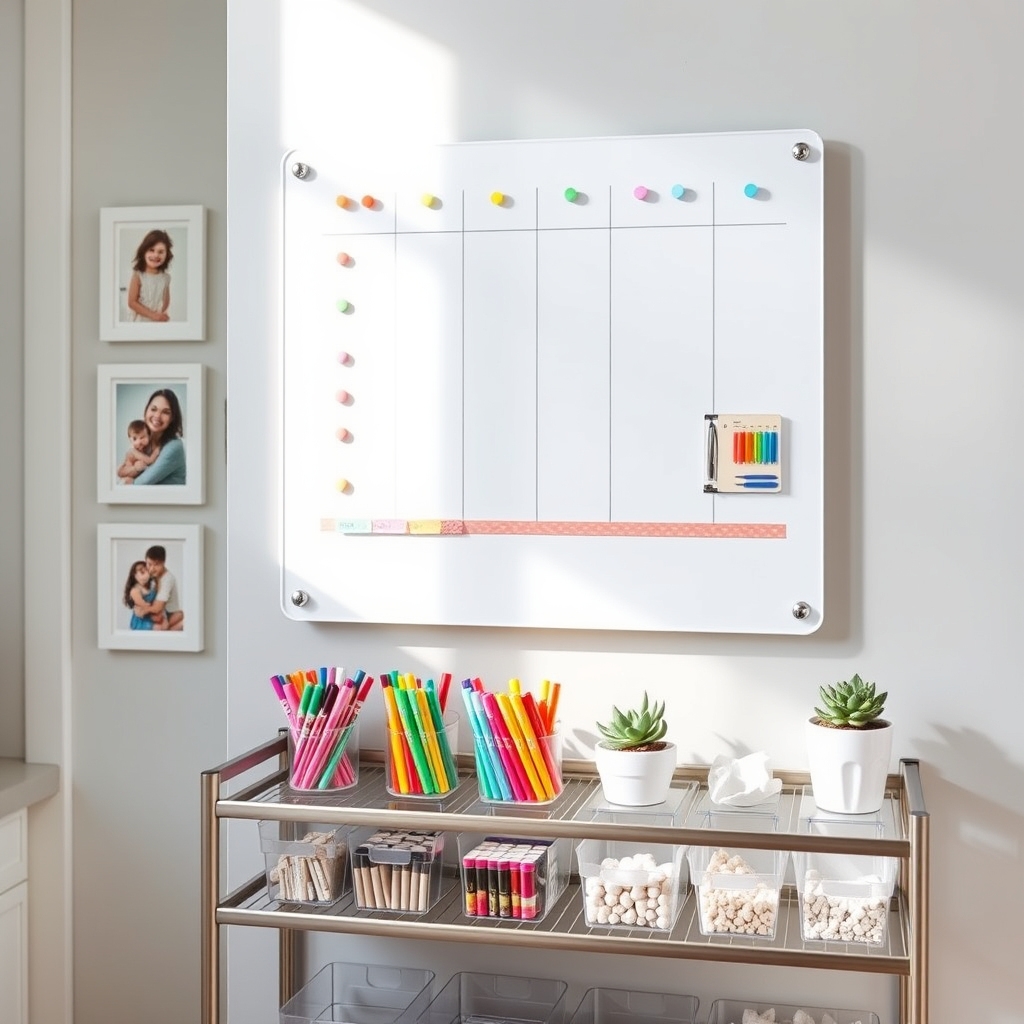
School Storage Ideas for Organized Homes With Kids
Implementing Weekly Schedule Boards
Weekly schedule boards are essential tools for keeping both parents and children on track during busy school weeks. They create a central command center where everyone can see upcoming assignments, activities, and responsibilities at a glance, reducing morning chaos and forgotten tasks.
Visual organization through schedule boards helps children develop time management skills and accountability while giving parents peace of mind knowing all important school-related activities are properly tracked. These boards also serve as an excellent way to teach children about planning and prioritizing their weekly commitments.
Required Items:
- Large magnetic or cork board
- Calendar grid template or ruled tape
- Dry erase markers (multiple colors)
- Magnetic strips or pushpins
- Weekly schedule template
- Storage hooks or pockets
- Labels
- Cleaning cloth
- Optional: magnetic containers for supplies
Select a visible location in your home, preferably near the main family area or kitchen. Create designated sections on the board for each family member using ruled tape or drawn lines. Include spaces for daily schedules, homework assignments, after-school activities, and important reminders.
Set up a color-coding system where each family member or activity type has its own color for easy identification. Install storage hooks or pockets below the board for necessary supplies and incoming papers.
Make the schedule board interactive by including movable elements like magnetic task cards or sticky notes that can be repositioned as plans change. Establish specific zones for “urgent,” “upcoming,” and “completed” items. Include a section for recurring weekly activities that remain consistent throughout the school year.
For maximum effectiveness, schedule a weekly family meeting every Sunday to update the board together. Teach children to check the board each morning and evening, marking off completed tasks and noting new assignments.
Keep extra supplies nearby for quick updates, and consider taking a photo of the board with your phone as a backup reference when away from home.
Develop After-School Drop Zones
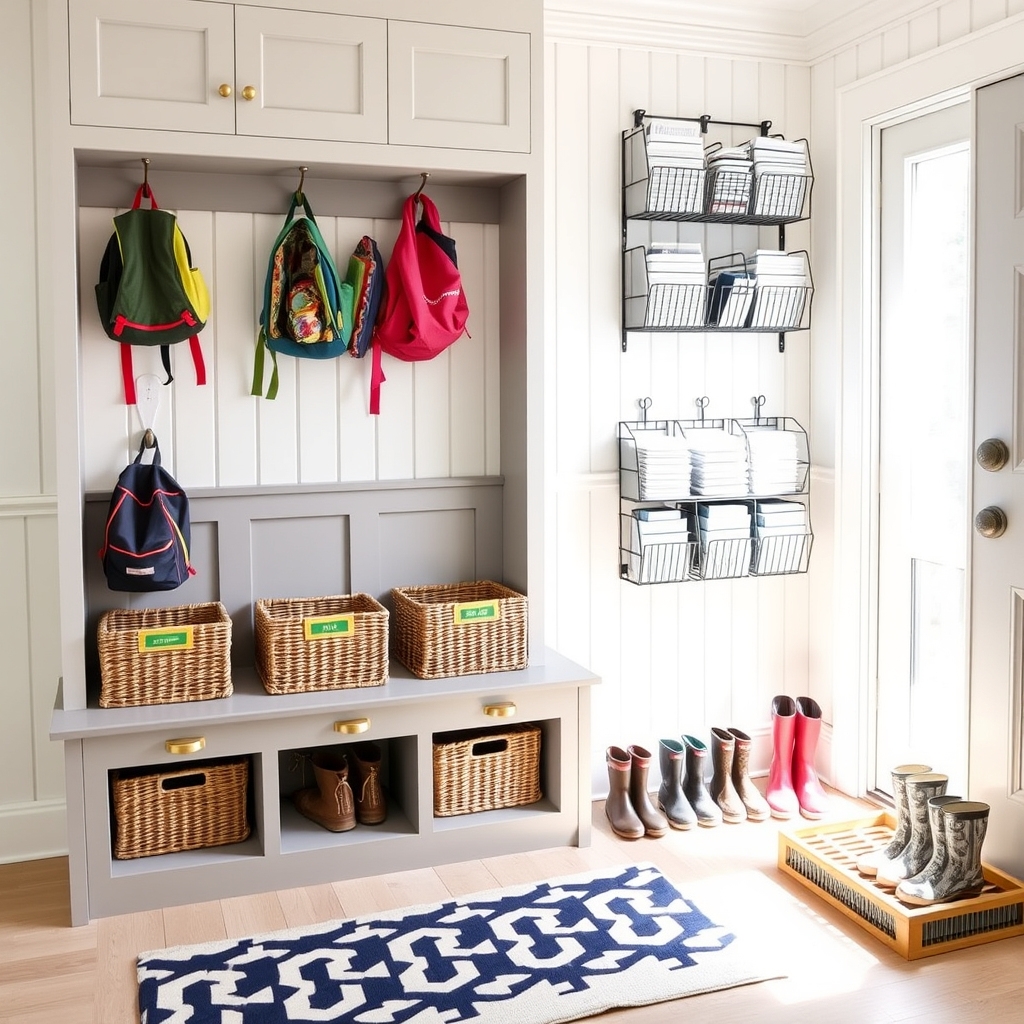
After-school chaos can quickly turn an organized home into a disaster zone as kids dump backpacks, sports equipment, and school materials wherever they land. A well-designed after-school drop zone creates a designated space for these items, preventing clutter from spreading throughout the house and making mornings run more smoothly.
Creating an efficient drop zone helps children develop organizational habits while keeping school-related items easily accessible. This system reduces stress, prevents lost homework, and maintains a cleaner home environment by containing potential mess to one specific area.
Required Items:
- Hooks or pegs for backpacks
- Storage bench or cubbies
- Label maker
- Baskets or bins
- Wall-mounted file holders
- Boot tray or shoe rack
- Command hooks or mounting hardware
- Paper sorter
- Charging station
- Bulletin board or magnetic board
The organization process starts with selecting an appropriate location, ideally near the most frequently used entrance. Install hooks at child-height for backpacks and coats, ensuring each child has their designated space.
Position a storage bench or cubby system below the hooks for shoes and sports equipment. Add labeled bins or baskets for each child’s supplies and papers requiring parent attention. Install a wall-mounted system for organizing incoming papers, permission slips, and homework assignments.
Create zones within the drop zone: an area for items needed the next day, a space for items that can stay home, and a designated spot for electronics charging. Use clear labels and color-coding to help children identify their spaces easily and maintain the organization system independently.
Success Tips: Implement a daily “reset” routine where children return items to their proper places before bedtime.
Consider seasonal adjustments to accommodate different equipment and clothing needs throughout the school year. Regular maintenance checks every few weeks help identify what’s working and what needs adjustment in your drop zone system.

